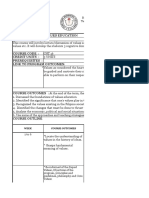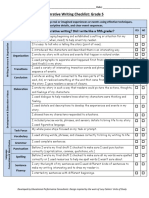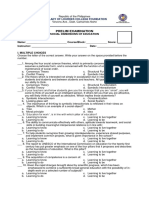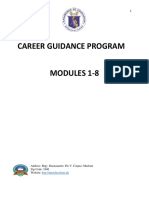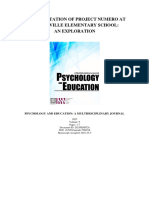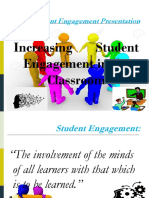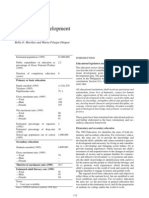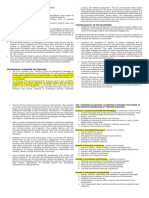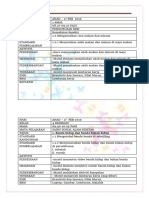Art of Questioning
Art of Questioning
Uploaded by
Walter Evans LasulaCopyright:
Available Formats
Art of Questioning
Art of Questioning
Uploaded by
Walter Evans LasulaOriginal Description:
Copyright
Available Formats
Share this document
Did you find this document useful?
Is this content inappropriate?
Copyright:
Available Formats
Art of Questioning
Art of Questioning
Uploaded by
Walter Evans LasulaCopyright:
Available Formats
ART OF QUESTIONING WHAT IS A QUESTION? A question is any sentence which has an interrogative form or function.
. In classroom settings, teacher questions are defined as instructional cues or stimuli that convey to students the content elements to be learned. Directions for what they are to do and how they are to do it.
WHAT ARE SOME TYPES OF QUESTIONS? James Gallaghers Categories of Questions as modified by A.C Ornstein (1990) to include Raths Valuing Levels 1. MEMORY QUESTIONS need recall of facts or discrete content items 2. CONVERGENT QUESTIONS require one correct response or a conventional answer. These deal with background information and are useful for practice and review. 3. DIVERGENT QUESTIONS involve high-level, critical-creative thinking. These allow many acceptable responses because they are often open-ended. 4. VALUING QUESTIONS explore students feelings and attitudes. Their emphasis is on the personal development through clarifying attitudes.
HOW EXPERTS VIEW THE ART OF QUESTIONING? instruction which includes posing questions during lessons is more effective in producing achievement gains than instruction carried out without questioning students oral questions posed during online recitations are more effective in fostering learning than are written question Posing questions before reading and studying material is effective for students who are older, high ability, and/or known to be interested in the subject matter Very young children and poor readers tend to focus only on material that will help them answer questions if these are posed before the lesson is presented asking more questions can improve their level of understanding than limited ones
WHY ASKING QUESTIONS IS IMPORTANT? Effective questioning will enable you to: P-romote an active learning environment E-xtend students analytical skills. D-evelop the communication skills I -nteract better with students G-ain an insight into your students knowledge R-ecognize and reward students. E-xercise creative thinking skills. E-mpower students to express their opinions
WHAT ARE SOME QUESTIONING TECHNIQUES?
1. Extending 2. Extending and lifting 3. Funneling 4. Sowing and reaping 5. Step-by-step up 6. Step-by-step down 7. Nose-dive 8. Random Walk WHAT QUESTIONS TO AVOID IN CLASS? 1. YES- NO questions 2. elliptical 3. tugging 4. guessing 5. leading 6. vague HOW TO IMPROVE QUESTION FRAMING? Teachers may 4 questioning techniques effectively in teaching: 1. Redirection is a questioning technique which increases student participation and prevents teacher domination. 2. Prompting uses hints and clues to assist a student to come up with a response successfully. 3. Probing is a questioning technique which deals with insufficient answers. It promotes reflective thought and critical thinking. 4. Wait time is the amount of time teachers wait after asking a question or more. It is the time teachers spend in waiting for students to respond.
EXERCISES ON QUESTIONING TECHNIQUES --------------------------------------------------------------------------------------------------------------------The Jay and the Peacock A JAY venturing into a yard where Peacocks used to walk, found there a number of feathers which had fallen from the Peacocks when they were moulting. He tied them all to his tail and strutted down towards the Peacocks. When he came near them they soon discovered the cheat, and striding up to him pecked at him and plucked away his borrowed plumes. So the Jay could do no better than go back to the other Jays, who had watched his behaviour from a distance; but they were equally annoyed with him, and told him: IT IS NOT ONLY FINE FEATHERS THAT MAKE FINE BIRDS. ---------------------------------------------------------------------------------------------------------------------------The Lion and the Mouse A LION was awakened from sleep by a Mouse running over his face. Rising up angrily, he caught him and was about to kill him, when the Mouse piteously entreated, saying: "If you would only spare my life, I would be sure to repay your kindness." The Lion laughed and let him go. It happened shortly after this that the Lion was caught by some hunters, who bound him by strong ropes to the ground. The Mouse, recognizing his roar, came and gnawed the rope with his teeth and set him free, exclaiming: "You ridiculed the idea of my ever being able to help you, expecting to receive from me any repayment of your favor; now you know that it is possible for even a Mouse to con benefits on a Lion." ---------------------------------------------------------------------------------------------------------------------------Sometimes the questions we ask are more important than answers we seek.~ Nancy Willard
You might also like
- A Study of Teacher Talk in Interactions inDocument11 pagesA Study of Teacher Talk in Interactions inWalter Evans Lasula100% (1)
- Course SyllabusDocument12 pagesCourse SyllabusJaymar MagtibayNo ratings yet
- 5th Grade Narrative Checklist For StudentsDocument1 page5th Grade Narrative Checklist For Studentssandeep_walia1499No ratings yet
- Office Orientation Unit PlanDocument4 pagesOffice Orientation Unit Planapi-51393783150% (2)
- Principles and Strategies of TeachingDocument11 pagesPrinciples and Strategies of TeachingKa NaNo ratings yet
- Issues and Concerns of Philippine Education Through The YearsDocument3 pagesIssues and Concerns of Philippine Education Through The YearsSweet MpndnNo ratings yet
- Professional Education 2Document13 pagesProfessional Education 2LordJim IgnacioNo ratings yet
- A Phenomenological Study On The Challenges and Problems of New Social Studies TeachersDocument19 pagesA Phenomenological Study On The Challenges and Problems of New Social Studies TeachersSteven BacalsoNo ratings yet
- Rubric For Lesson Plan 1Document2 pagesRubric For Lesson Plan 1Laila KamarudinNo ratings yet
- Val Ed SyllabusDocument25 pagesVal Ed Syllabusroy piamonteNo ratings yet
- Advanced Curriculum Development - Curriculum and Managment of LearningDocument2 pagesAdvanced Curriculum Development - Curriculum and Managment of Learningjerome100% (1)
- LET Reviewer Part 1Document28 pagesLET Reviewer Part 1Neil AngNo ratings yet
- Competent Teachers:: Effective Classroom ManagersDocument25 pagesCompetent Teachers:: Effective Classroom ManagersWilson Alvin PaciolcoNo ratings yet
- Social Dimensions of Education Prelim ExamDocument4 pagesSocial Dimensions of Education Prelim ExamMaria Faye MarianoNo ratings yet
- The Paradigm Shift in TeachingDocument20 pagesThe Paradigm Shift in TeachingShena GadiaNo ratings yet
- Prof. Ed - Prof. JudyDocument12 pagesProf. Ed - Prof. JudyJunril CabadongaNo ratings yet
- The Teacher The Community School Culture and Organizational LeadershipDocument14 pagesThe Teacher The Community School Culture and Organizational LeadershipGlen Rose CadeliñaNo ratings yet
- What, Why and How To Evaluate A CurriculumDocument32 pagesWhat, Why and How To Evaluate A CurriculumJeremias De la CruzNo ratings yet
- Strategies of Curriculum Changes in The PhilippineDocument4 pagesStrategies of Curriculum Changes in The PhilippineAngie Olpos Boreros Baritugo100% (1)
- A Narrative Report in CWTSDocument6 pagesA Narrative Report in CWTSdane VillanuevaNo ratings yet
- EDUC 109 - Week 7 - The Teacher and The School CurriculumDocument5 pagesEDUC 109 - Week 7 - The Teacher and The School CurriculumReym Miller-DionNo ratings yet
- Education in The PhilippinesDocument54 pagesEducation in The PhilippinesJunaidNo ratings yet
- Organizational LeadershipDocument22 pagesOrganizational LeadershipKean Roi cabanosNo ratings yet
- Career Guidance Program: Address: Brgy. Buenasuerte, Pio V. Corpuz, Masbate Zip Code: 5406 WebsiteDocument44 pagesCareer Guidance Program: Address: Brgy. Buenasuerte, Pio V. Corpuz, Masbate Zip Code: 5406 WebsiteAvi Auerbach Avila100% (1)
- Teacher Salary Essay - 2Document9 pagesTeacher Salary Essay - 2api-287745696No ratings yet
- Principal and TeachersDocument15 pagesPrincipal and TeachersOnjhong FaeldenNo ratings yet
- School Based CoachingDocument4 pagesSchool Based Coachingapi-381526233No ratings yet
- Educational Leadership and Creative Strategies EducationDocument3 pagesEducational Leadership and Creative Strategies EducationJofel Christian F Meneses100% (1)
- Unit I: Introduction of Key Concepts: Study Guide For Module No. - 1Document25 pagesUnit I: Introduction of Key Concepts: Study Guide For Module No. - 1Billy CruzNo ratings yet
- Writing Good Multiple Choice Test QuestionsDocument10 pagesWriting Good Multiple Choice Test QuestionsAndi Ulfa Tenri PadaNo ratings yet
- 200 Questions Prof - Ed 2017Document19 pages200 Questions Prof - Ed 2017Winzell FernandezNo ratings yet
- Chapter 1 Lesson 3 Curriculum Development Process and ModelDocument17 pagesChapter 1 Lesson 3 Curriculum Development Process and ModelAriell EmraduraNo ratings yet
- Models of Teaching 'Jurisprudential"Document23 pagesModels of Teaching 'Jurisprudential"SitiUmmiLatifah100% (2)
- EDUC 205 LESSON No. 1 (LM # 4 Final)Document8 pagesEDUC 205 LESSON No. 1 (LM # 4 Final)Ellarence RafaelNo ratings yet
- Implementation of Project Numero at Cresdaville Elementary School: An ExplorationDocument7 pagesImplementation of Project Numero at Cresdaville Elementary School: An ExplorationPsychology and Education: A Multidisciplinary JournalNo ratings yet
- Seameo Innotech Study NotesDocument25 pagesSeameo Innotech Study NotesPrincess Joy GavileñoNo ratings yet
- San Pablo Colleges Master of Arts in NursingDocument35 pagesSan Pablo Colleges Master of Arts in NursingMike Ong100% (1)
- Profed 4Document7 pagesProfed 4Hanna Grace HonradeNo ratings yet
- How Do You Effectively Engage Your Students in LearningDocument22 pagesHow Do You Effectively Engage Your Students in LearningKim B. AlcanceNo ratings yet
- Philippine Curriculum DevelopmentDocument8 pagesPhilippine Curriculum Developmentmartygalvez88% (16)
- First Day May 25, 2015 Foundation Subjects 1. MORDocument3 pagesFirst Day May 25, 2015 Foundation Subjects 1. MORNaquines Bachicha QueenlyNo ratings yet
- The Distinguished TeacherDocument6 pagesThe Distinguished TeacherRichel Lizardo Uy0% (2)
- Guiding Principles in Classroom ManagementDocument2 pagesGuiding Principles in Classroom Managementkimmy mendez100% (1)
- Learning PrinciplesDocument2 pagesLearning PrinciplesDaniela ParNo ratings yet
- The Three Types of Curriculum DesignDocument5 pagesThe Three Types of Curriculum DesignChuck Daniel Ulep100% (1)
- Course Outline - Building and Enhancing New Literacies Across CurriculumDocument3 pagesCourse Outline - Building and Enhancing New Literacies Across CurriculumNORADY MERCADONo ratings yet
- 5e Inquiry Lesson Plan NewDocument4 pages5e Inquiry Lesson Plan Newapi-506655267No ratings yet
- Administration and Supervision-1Document25 pagesAdministration and Supervision-1Verisse100% (1)
- Classroom Instruction and Management PracticesDocument16 pagesClassroom Instruction and Management PracticesSiti Noor WahidaNo ratings yet
- Uses and Gratification TheoryDocument11 pagesUses and Gratification TheoryDiani MukhtarNo ratings yet
- Philippine Professional Standards For Teachers (PPST) August 11, 2017 Deped Order No. 42, S. 2017Document3 pagesPhilippine Professional Standards For Teachers (PPST) August 11, 2017 Deped Order No. 42, S. 2017GSCNo ratings yet
- The Lesson Plan Kinds Formt Components of The Lesson PlanDocument4 pagesThe Lesson Plan Kinds Formt Components of The Lesson PlanWinnie Joy ApolonioNo ratings yet
- Curriculum Design and DevelopmentDocument32 pagesCurriculum Design and DevelopmentKenneth Gomez75% (4)
- TEACHING IN THE SPECIALIZED FIELD (Module 1)Document6 pagesTEACHING IN THE SPECIALIZED FIELD (Module 1)Maria Angelica DeniaNo ratings yet
- Teaching and LearningDocument29 pagesTeaching and LearningAnurag GuptaNo ratings yet
- CEAP JEEPGY Academy Day 1 - Transformative Education and The School System PDFDocument23 pagesCEAP JEEPGY Academy Day 1 - Transformative Education and The School System PDFKaren GayNo ratings yet
- Prof. Ed - Principles and Theories of Learning and Motivation Part 1-2Document4 pagesProf. Ed - Principles and Theories of Learning and Motivation Part 1-2Marisol Altobar Palatino0% (1)
- DESIGNING LEARNING MODULES AutosavedDocument22 pagesDESIGNING LEARNING MODULES Autosavedtfeybi56No ratings yet
- Session 2: M L P Objective:: Y Evel of ReparednessDocument11 pagesSession 2: M L P Objective:: Y Evel of ReparednessSharlyn SefanieJamzelian A PedroNo ratings yet
- Sped Gifted ReportDocument25 pagesSped Gifted Reportrowena OpocNo ratings yet
- The Art of Questioning in Critically Thoughful Classroom: Ms. Del RiveraDocument40 pagesThe Art of Questioning in Critically Thoughful Classroom: Ms. Del RiveraAngela Jane Santos100% (1)
- Literature in Elt "What Is Good Teaching?"Document36 pagesLiterature in Elt "What Is Good Teaching?"phitaNo ratings yet
- 8601 AssignmentDocument17 pages8601 Assignmentmj0780603No ratings yet
- Ielts: All Rights Reserved 2014©Document13 pagesIelts: All Rights Reserved 2014©Walter Evans LasulaNo ratings yet
- Give The Name of The Landmark and The Place It Is LocatedDocument39 pagesGive The Name of The Landmark and The Place It Is LocatedWalter Evans LasulaNo ratings yet
- Superlative Speaking Cards Fun Activities Games Warmers Coolers 27874Document2 pagesSuperlative Speaking Cards Fun Activities Games Warmers Coolers 27874Walter Evans LasulaNo ratings yet
- Playing Cards Speaking ActivityDocument5 pagesPlaying Cards Speaking ActivityWalter Evans LasulaNo ratings yet
- You Should Write at Least 150 Words.: The Graph Below Compares The Number of Visits To Two New Music Sites On The WebDocument1 pageYou Should Write at Least 150 Words.: The Graph Below Compares The Number of Visits To Two New Music Sites On The WebWalter Evans LasulaNo ratings yet
- Art of Effective EvaluationDocument12 pagesArt of Effective EvaluationWalter Evans LasulaNo ratings yet
- Guess The Famous Landmarks: Give The Name of The Landmark and The Place It Is LocatedDocument39 pagesGuess The Famous Landmarks: Give The Name of The Landmark and The Place It Is LocatedWalter Evans LasulaNo ratings yet
- 03 Chapter 1 - FeedbackDocument8 pages03 Chapter 1 - FeedbackWalter Evans Lasula100% (1)
- Are The Competencies..Document2 pagesAre The Competencies..Walter Evans LasulaNo ratings yet
- Powerpoint Title: Subtitle Goes HereDocument2 pagesPowerpoint Title: Subtitle Goes HereWalter Evans LasulaNo ratings yet
- Brainstorming and OutliningDocument7 pagesBrainstorming and OutliningWalter Evans LasulaNo ratings yet
- Baggage TagDocument1 pageBaggage TagWalter Evans LasulaNo ratings yet
- British LiteratureDocument14 pagesBritish LiteratureWalter Evans LasulaNo ratings yet
- Answering Multiple Choice On ExamDocument2 pagesAnswering Multiple Choice On ExamWalter Evans LasulaNo ratings yet
- Bit CoinsDocument19 pagesBit CoinsWalter Evans LasulaNo ratings yet
- Toastmasters Corporate Club BenefitDocument3 pagesToastmasters Corporate Club BenefitWalter Evans LasulaNo ratings yet
- Classroom Management BehaviorsDocument1 pageClassroom Management BehaviorsWalter Evans LasulaNo ratings yet
- 03 Chapter 1 - FeedbackDocument8 pages03 Chapter 1 - FeedbackWalter Evans Lasula100% (1)
- Picture Paints Thousand WordsDocument23 pagesPicture Paints Thousand WordsWalter Evans LasulaNo ratings yet
- Role of The Assessor, Candidate, ModeratorDocument5 pagesRole of The Assessor, Candidate, ModeratorWalter Evans Lasula0% (1)
- Artificial Intelligence in EducationDocument9 pagesArtificial Intelligence in EducationBewket MulugetaNo ratings yet
- 2022 2023 Criteria in Judging Literary PortrayalDocument2 pages2022 2023 Criteria in Judging Literary PortrayalJaylyn Navarro AlfaroNo ratings yet
- BST Prompt Fading EditDocument1 pageBST Prompt Fading EditMAJ MACHADONo ratings yet
- Idiomatic Expressions Lesson PlanDocument9 pagesIdiomatic Expressions Lesson Planjamaica chris tomeNo ratings yet
- Precalculus Activity Sheets Q2 w5&6Document4 pagesPrecalculus Activity Sheets Q2 w5&6debate ddNo ratings yet
- In Thi CH 202: Aviation Area of Concentration 9-15 18-27Document1 pageIn Thi CH 202: Aviation Area of Concentration 9-15 18-27Earthace6No ratings yet
- Paragraph WritingDocument2 pagesParagraph WritingHeiMiNo ratings yet
- GRADES 1 To 12 Daily Lesson Log: Write The LC Code For EachDocument3 pagesGRADES 1 To 12 Daily Lesson Log: Write The LC Code For EachJohn Giles Jr.No ratings yet
- Text - Final Exam - Mayo 2023Document3 pagesText - Final Exam - Mayo 2023Romina ContrerasNo ratings yet
- GR.6 Practical ResearchDocument4 pagesGR.6 Practical ResearchRovi Gie ArabitNo ratings yet
- F08120000220104012F0812 P12 Behavioural Research in AccountingDocument34 pagesF08120000220104012F0812 P12 Behavioural Research in AccountingHasim kunNo ratings yet
- Full Report Persuasive SpeechDocument24 pagesFull Report Persuasive SpeechWany RadziNo ratings yet
- 4a's Lesson Plan in Physical Education (P.E) 3Document4 pages4a's Lesson Plan in Physical Education (P.E) 3John Mar ʚĩɞ0% (1)
- Shriwardhan ResumeDocument4 pagesShriwardhan ResumeShraddha AgrawalNo ratings yet
- Sdo-Tarlac-Province Ldm2portfolio Teacher Flores GlaizaDocument17 pagesSdo-Tarlac-Province Ldm2portfolio Teacher Flores GlaizaGlaiza FloresNo ratings yet
- Organizational Skills Quiz TipsDocument1 pageOrganizational Skills Quiz TipsЛюдмила БаценкоNo ratings yet
- Lesson PlanningDocument21 pagesLesson PlanningeaglesnestownersNo ratings yet
- Fernandez School Librarian ResumeDocument2 pagesFernandez School Librarian Resumeapi-459197730No ratings yet
- OPTIMIZATION-Shuffled Frog Leaping AlgorithmDocument15 pagesOPTIMIZATION-Shuffled Frog Leaping AlgorithmUday WankarNo ratings yet
- English 7 Learning Activity Sheet: Quarter 3 - Module 4Document6 pagesEnglish 7 Learning Activity Sheet: Quarter 3 - Module 4Bret Michael GripoNo ratings yet
- Pythagorean Triangle Numerology 4Document7 pagesPythagorean Triangle Numerology 4archanaNo ratings yet
- The USe of Process Approach in WritingDocument9 pagesThe USe of Process Approach in WritingHedhedia Cajepe100% (1)
- Lesson Plan in Teaching English 10: Think-Pair-Share: The Teacher Will Ask The Pupils About TheirDocument3 pagesLesson Plan in Teaching English 10: Think-Pair-Share: The Teacher Will Ask The Pupils About TheirGomonan RosannaNo ratings yet
- Constructing Writing Practices in Nursing: Kim M. Mitchell, BA, MN, RNDocument9 pagesConstructing Writing Practices in Nursing: Kim M. Mitchell, BA, MN, RNRreginaldRodclyNo ratings yet
- Model-Model Riset Dan Evaluasi Public RelationDocument7 pagesModel-Model Riset Dan Evaluasi Public RelationRetnoWuislan100% (1)
- American English File 1 Workbook (PDFDrive - Com) - 5 PDFDocument1 pageAmerican English File 1 Workbook (PDFDrive - Com) - 5 PDFestefani33% (3)
- Benda Hidup Dan Benda Bukan HidupDocument11 pagesBenda Hidup Dan Benda Bukan HidupVanessa SchultzNo ratings yet
- Defining Morality and What Could Be The Differences Between Moral Standards and Non-Moral?Document4 pagesDefining Morality and What Could Be The Differences Between Moral Standards and Non-Moral?Khaye SabaytonNo ratings yet

